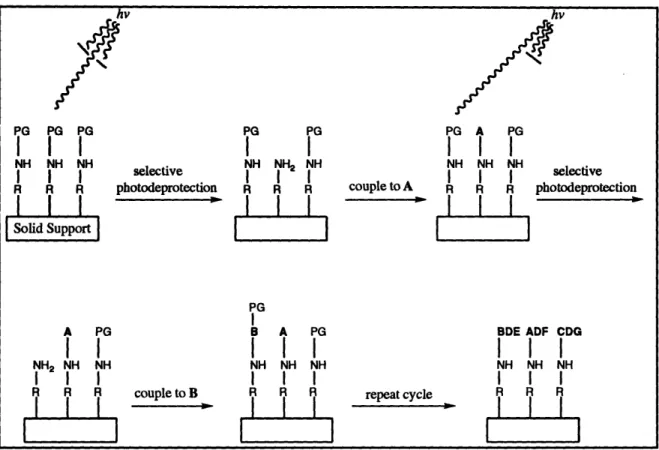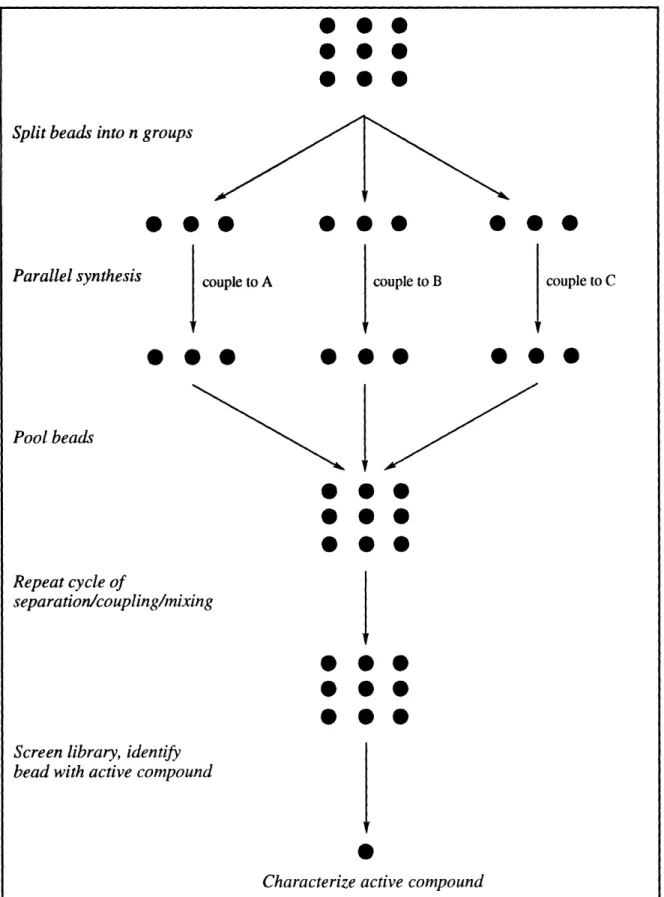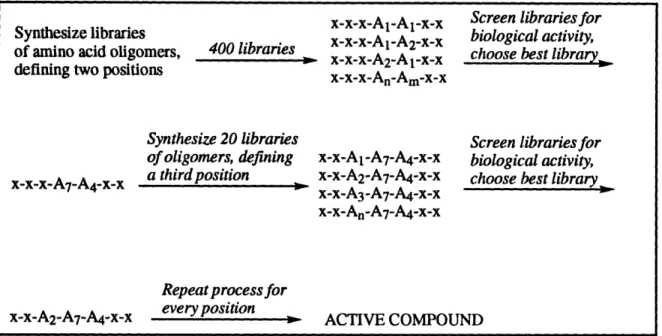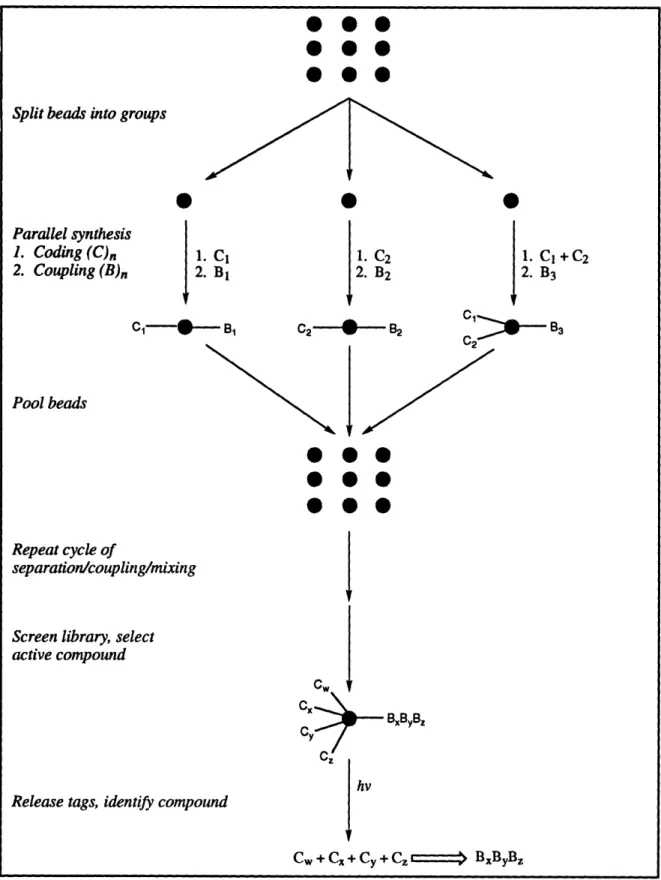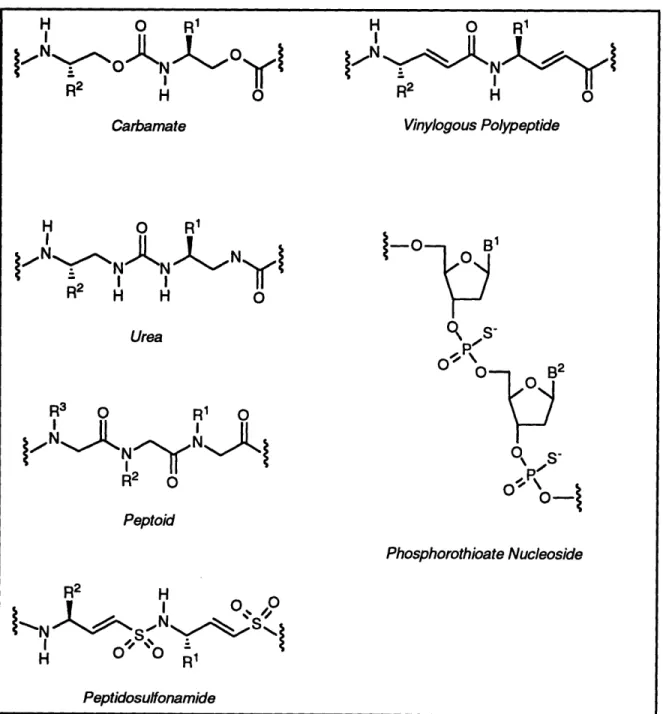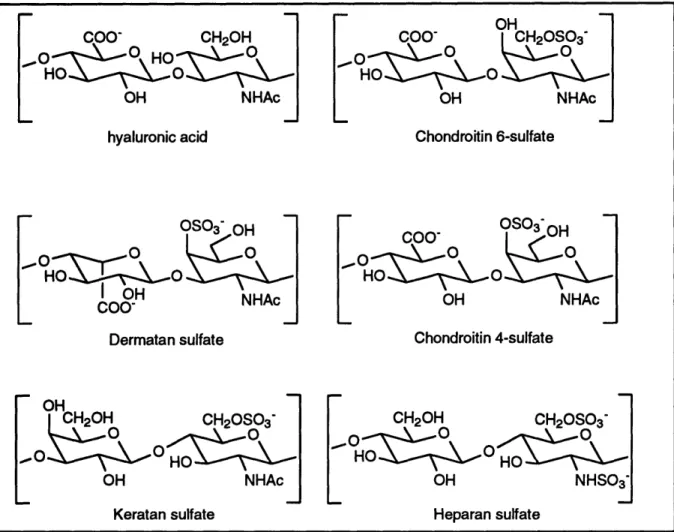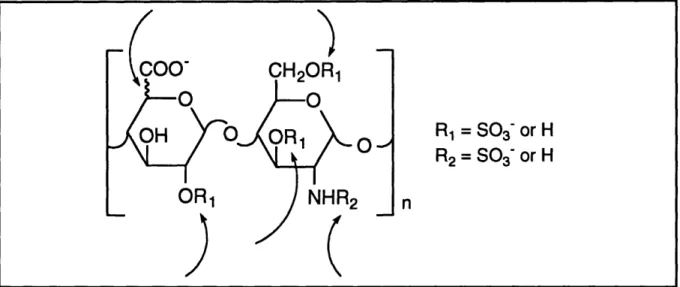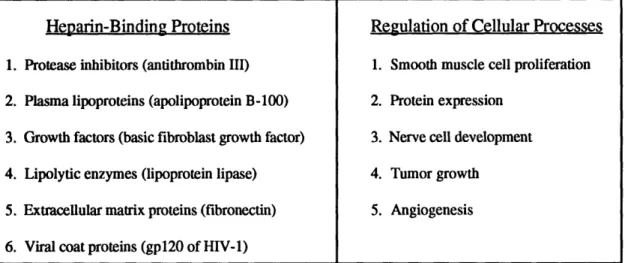APPROACHES TO CARBOHYDRATE-BASED CHEMICAL
LIBRARIES: THE EVOLUTION OF GLYCOTIDES
by
Jason Patrick McDevitt
B.A., Chemistry, Yale University (1989)
Submitted to the Department of Chemistry in Partial
Fulfillment of the Requirements for the Degree of
Doctor of Philosophy
at the
Massachusetts Institute of Technology
June, 1995© 1995 Massachusetts Institute of Technology
All rights reserved
'-Signature of Author
....o he istry
"''DepartmentDepartment
olh stry
May 24, 1995 ,l
Certified
by ...
/.-
.-...
Associe / Peter T. Lansbury, Jr.
a-Associate Professor of Chemistry
Thesis Supervisor
Accepted
by ...
... ...
Dietmar Seyferth Chairman, Departmental Committee on Graduate Students
Science
This doctoral thesis has been examined by a Committee of the Department of Chemistry as follows:
Professor James R. Williamson
Professor Peter T. Lansbury, Jr.
I . . . ..
Chairman
Supervisor
Professor Scott C.
Virgil
..
...
I.
.
...
. .. .~
APPROACHES TO CARBOHYDRATE-BASED CHEMICAL
LIBRARIES: THE EVOLUTION OF GLYCOTIDES
by
Jason Patrick McDevitt
Submitted to the Department of Chemistry on May 24, 1995, in partial fulfillment of the requirements for the Degree of
Doctor of Philosophy
ABSTRACT
The overwhelming majority of commercial drugs have been discovered by random screening methods. The chance of finding active compounds in a biological screen is improved by having a large and diverse pool of molecules from which to choose. This simple notion has led to the development of combinatorial chemistry. Instead of using a
serial approach to synthesis, chemists make compounds in a parallel fashion, thereby
enabling rapid synthesis of large chemical libraries. Time is saved by avoiding purification of intermediates, and thus combinatorial chemistry places a great emphasis on performing reactions that proceed in high yields.Carbohydrates are an underutilized but potentially ideal class of building blocks for
combinatorial chemistry because they package substantial complexity into compact molecular structures. The glycosaminoglycan heparin is an example of a naturalcarbohydrate library in which seemingly small variations in a repeating skeletal core give
rise to a broad range of biological activities. We sought to produce heparin mimetics by a
semi-synthetic route. Heparinase cleavage was used to produce fragments that could be modified and subsequently linked with a Michael addition. The complexity of the natural system led us to synthesize a monosaccharide Michael acceptor as a model system. We studied the Michael addition of various thiolates to the model compound. Unfortunately, nucleophilic attack proceeded primarily from the re (top) face, giving adducts with differentstereochemistries than those found in heparin. Furthermore, thioglycosides were incapable
of Michael addition. We attempted to synthesize combinatorial libraries using the Michaeladdition with glycoconjugates, but yields were low.
We wanted to utilize carbohydrate building blocks, but needed a highly efficient reaction to
couple them. We functionalized monosaccharides with an amine and a carboxylic acid,thereby producing glycosamino acids. These monomeric units were linked with amide
bonds to produce glycotides. We have synthesized several classes of glycosamino acids
(protected as azido esters), and have synthesized defined oligomers, small libraries of linear glycotides, and template-directed libraries.Thesis Supervisor: Peter T. Lansbury
Title: Associate Professor of Chemistry
Table of Contents
Acknowledgments ...
...
6
Chapter 1: Introduction to Combinatorial Chemistry ...
8
Overview of combinatorial chemistry
...
8
Approaches to combinatorial library synthesis ...
11
Classes of combinatorial libraries ... 20
Future directions
...
24
References for Chapter 1 ...
... 26
Chapter 2: Heparin-Based Libraries ...
30
Introduction to heparin
...
...
30
Heparin libraries
...
33
An approach to sulfur-linked heparinoids
...
37
References for Chapter 2 ...
... 42
Chapter 3: Michael Addition of Thiolates to an a,3-Unsaturated
Glycopyranosyluronate Ester
...
44
Synthesis of a model Michael acceptor ...
44
Michael addition of thiolates ...
44
The stereochemistry of addition depends on two independent processes .... 50
Reversibility of the Michael addition ...
53
Use of 2-mercaptoethanol (BME) as the thiol nucleophile ... 55
Structural assignments
...
...
58
References for Chapter 3 ...
... 60
Chapter 4: Applications of the Michael Addition ...
61
Synthesis of thiodisaccharides using the Michael addition ... 61
An alternative approach to library formation using the Michael addition ... 65
Characteristics of a highly desirable combinatorial library ... 72
References for Chapter 4
...
... 75
Chapter 5: Glycotides: Synthesis of Glycosamino Amino Acid Monomers ... 77
Introduction to Glycotides
...
77
Monomer synthesis:
an overview
...
79
Synthesis of glycosamino acids from hexose sugars ...
82
Synthesis of glycosamino acids from pentose sugars ...
88
Efficiency of monomer synthesis
...
92
Conversion of monomers into suitable forms for solid phase synthesis ... 93
References for Chapter 5
...
... 97
Chapter 6: Glycotides: Oligomer and Library Synthesis ... 100
Synthesis of glycotide libraries: an overview ...
100
Glycotide synthesis in solution ...
102
Solid phase synthesis of glycotides
...
111
Conclusions
...
113
References for Chapter 6
...
...
116
Chapter 7: Experimental Section ...
...
118
Index of experimental procedures ...
...
118
General information
....
... ...
122
Experimentals for Chapter 2 ...
123
Experimentals for Chapter 3 ...
126
Experimentals for Chapter 4 ...
147
Experimentals for Chapter 5 ...
163
Experimentals for Chapter 6 ...
242
Acknowledgments
I owe a debt of gratitude to many people, and the longest-owed and least-paid debt
is to my parents. There is no way I can adequately express my thanks for their unwavering
love for the past 27 years. I sincerely hope that their happiness and excitement with their
new mountaintop lifestyle does not fade.
I would also like to thank the rest of my family for their unconditional support.
Hopefully, I will be able to see more of them now that I am finished here. In particular, I'd
like to congratulate my sister Erin on her recent engagement.Although having been somewhat less than blissfully content with my surroundings
in Cambridge, I have thoroughly enjoyed my five years as a graduate student. My lab has always been a very positive environment, and much of the credit for that should go to Peter Lansbury. He has always gone to extremes to ensure that his role as the boss never came before his role as a person. Peter is an all-around good guy and is one of a small minority of faculty members who manages to hide a truly sharp mind behind an unpretentious exterior. Since Peter was wrongly denied tenure, I have to wish him luck in his new job.The rest of the credit for the positive working environment during graduate school
goes to my labmates, too numerous to mention individually. Long before my arrival, Kurt Halverson was one of the original four students in the lab, and he made great contributions not only academically, but more importantly in establishing a positive tone for the lab.Long after founding morning ball, writing his thesis, and getting a job at 3M, Kurt showed
his tremendous clout by bullying his employers into making me a job offer. It was a very hard decision not to accept that offer, but I am very grateful for the opportunity. I'd like to thank the two men who had the misfortune to be my baymates, Jim Harper and Luncong Dong. They had to contend with my unceasing efforts to colonize all free space in the hood, and I offer them a belated apology. In particular, I'd like to express my gratitude toSantosh Nandan and Cheon-Gyu Cho, two postdocs who diligently tried to transform a
stubborn pupil into a real organic chemist.I have been fortunate to enjoy many activities outside of work while in graduate school. Jon Come founded the lunchtime bridge game, claims to be a co-founder of morning ball, and was certainly an energizing force behind everything he did. I enjoyed pick-up games and intramural sports while at MIT, particularly with the chemical engineers and their affiliated ringers. Best of luck to them, as well as the Harvardians. I hope the Commish can find someone who can give him a game.
I have always been able to escape from MIT even while in Cambridge. My
roommates for two years, Alex Pfaff and Kingsley Taft, were students at MIT but were
really just Yalies passing through. I have been able to see friends from college throughoutmy time here, and I regret (because of my indolence, for which I will pay) not doing it
more frequently. I have followed Steve Cass from New Haven to the trailer park in
Edwards to Boston, and now I can't help but think that the Tri-Cities area has a place for
him.
I will always reflect fondly on graduate school because it was here that I had the incredible good fortune to meet Marcella. Because of her, all of the frustrations that I experienced as a graduate student seemed so trivial, and faded as soon as I left the lab and headed home. She has been forced to make many sacrifices and difficult decisions while I
have been stuck in graduate school, and hopefully now she will get all that she has coming.
Chapter 1
Overview of Combinatorial Chemistry
The pharmaceutical industry is currently undergoing dramatic transformations as a
result of a confluence of economic, political, legal, and technological pressures. Among
the most profound of these changes is a fairly new approach to drug development known
as combinatorial chemistry. The goal of combinatorial chemistry is to rapidly produce large and diverse chemical libraries as sources of lead compounds and viable pharmaceuticals.Traditional approaches to drug discovery have relied upon identification of lead
compounds from random screening, followed by serial optimization of the leads
14. Lead
compounds are obtained by screening synthetic chemical libraries and natural products isolated from animal sources, plant extracts, and microbial fermentations. The leads are then laboriously refined into drug candidates through a process of systematic optimization. Sequential modifications of the lead compounds are individually synthesized and tested for activity, with beneficial changes retained and detrimental ones discarded. Of course,
changes are not necessarily additive, and this factor further retards the evolutionary process
of medicinal chemical optimization. Undeniably, the traditional approach to drugdevelopment has been successful, but increasing competition for shrinking profits has
dictated an industry-wide search for a faster and more cost-effective approach.
One such approach is structure-based rational drug design.* Conceptually, rational drug design is very simple. If one can define the three-dimensional structure of a target molecule of known biological importance, then it should be possible to "design"
compounds which can interact with the target in a very specific manner, thereby producing a high-potency drug with minimal side effects. In practice, rational drug design is plagued
by several logistical problems
5-
8, the most important of which is obtaining a highly precise
* Since it has been used widely for many years, mechanism-based drug design can be classified as a subset of the traditional approach to drug development.
physical structure of the biologically active conformation of the target. It is critical to obtain the three-dimensional structure of the bioactive conformation in solution, which is likely to
differ from the solid-state crystal structure or the thermodynamically favored solution
structures. Furthermore, the uncertainties of the methods used to obtain three-dimensional
structures of biomolecules, i.e., x-ray crystallography and two-dimensional NMR, are on
the same order as the size of atoms
7,
8. Obviously, greater precision in the structures of the
biological target would facilitate drug design.There have been some published successes involving rational drug design
5 8 9.
Furthermore, many of the barriers to success are largely technical in origin, and thus it is
likely that rational drug design will become increasingly effective in the future.Nevertheless, progress has been disappointingly slow, and in spite of its enormous
potential, rational drug design has not emerged as a general, cost-effective alternative totraditional drug discovery approaches.
Undoubtedly, the slow progress of rational drug design has contributed to the
enormous appeal of combinatorial chemistry. If development of a drug candidate depends
on finding a compound with a particular biological interaction, and if it is impossible to accurately predict whether a given compound will possess the desired interaction, then thechance of finding a potential therapeutic is improved by having a large and diverse pool of
molecules from which to choose. Pharmaceutical companies have access to vast and fairly diverse sets of discrete chemical entities, and chemists certainly could synthesize "libraries"of novel compounds using traditional methods. Thus, combinatorial chemistry is
distinguished by the emphasis on making libraries of compounds rapidly. Stripped to its
essence, combinatorial chemistry is a labor-saving device.
The operational objective of combinatorial chemistry is to make many compounds in the amount of time previously required to make a single compound. This is achieved by
performing chemical synthesis in parallel rather than in series. Unfortunately, organic
chemistry is not routinely amenable to parallel synthesis. The rate-determining process in
most organic syntheses is the purification of intermediates and a final product. In other
words, the majority of a chemist's time is spent not in starting reactions, but rather in
finishing (work-up and purification) them. In order for parallel synthesis to meet its goal
of drastically reducing the time per chemist per compound, the rate-limiting step in thesynthetic process must be circumvented, and therefore invasive purification techniques
(chromatography, recrystallization, etc.) are avoided.* As a consequence, approaches tocombinatorial chemistry place a great emphasis on reactions that proceed in high yields,
with reactants and byproducts that are either benign or easily removed. Although solid
phase chemistry is not a required component of combinatorial chemistry, it is highlycompatible. Solid phase synthesis allows the use of an excess of reagents to drive a
reaction to completion, after which the reagents, byproducts, and solvent are removed by filtration. Therefore, it should not be surprising that the initial approaches to combinatorialchemistry involved making libraries of oligopeptides
l 0 - 12and oligonucleotides
3,'
14, since
solid phase synthesis of these biopolymers
'
151 7has been very well-refined.
There appears to be a widely held impression that the purpose of combinatorial chemistry is to produce new leads in drug discovery. From the perspective of a
pharmaceutical company, the goal is obviously to shorten the drug development cycle.
There are probably very few biological assays that would not realize many "hits" when
screened by the myriad of chemicals to which a pharmaceutical company has access. Inorder for combinatorial chemistry to provide some improvements, the combinatorial
libraries must avoid redundancy and serve as a source of novel lead compounds with
superior properties. Perhaps the stated purpose might be better phrased: "to produce
superior new leads in drug discovery". This would entail the discovery of more lead
structures, possessing higher affinities, significant conformational restraints, greater
potential for optimization, easier synthesis, better pharmacokinetic properties, etc. Given
* The alternative, parallel synthesis with invasive purification, is simply the standard operating procedure for organic chemists, provided the number of parallel syntheses (n) is small. When n becomes large (approximately 5, depending on the organizational skills of the chemist), efficiency rapidly declines.
these potential benefits, the search for superior new leads is sufficient to justify an
investment in combinatorial chemistry. Nevertheless, this stated purpose is artificially
limiting and presents a somewhat myopic view of the potential of combinatorial chemistry.
The methodical process of refining and optimizing lead compounds normally
requires significantly more time than that spent in identifying leads
3,5. Consequently, if the
goal is to substantially reduce the portion of the drug development cycle devoted to drug discovery, one must find a way to facilitate the optimization process. Therein lies the truepotential of combinatorial chemistry. The ultimate goal of combinatorial chemistry is not
only to provide a source for new and perhaps superior lead compounds, but also to provide
a suitable framework for iterative rounds of combinatorial optimization.Approaches to Combinatorial Library Synthesis
It is easy to understand how combinatorial chemistry can be used to generate vast
chemical libraries. The size of a library is an exponential function of the number of
synthetic steps and different chemical reagents available for each step (see Table 1-1).Assuming one wishes to employ a building block approach to combinatorial synthesis,
with the number of building blocks represented by x and the number of couplings
represented by y, then the total number of compounds N = xY. There are 20 common
amino acids, and thus there are 8,000 (203) possible tripeptides, 160,000 (204)
tetrapeptides, etc. Increases in the library size can be obtained by either increasing thenumber of building blocks or increasing the number of coupling steps. Nature has chosen
the latter strategy, and the enormous diversity that can be achieved by repeated ligations of a relatively small number of building blocks is exemplified by the genetic code. The former strategy is more appealing to a pharmaceutical company, since it reduces the number ofsynthetic steps and keeps the molecular weights of the compounds sufficiently low
(generally < 700)2 to maintain desirable levels of oral bioavailability.Table 1-1. Library size is a function of the number of building blocks and coupling steps.
There are two fundamental challenges in combinatorial chemistry. The first is to generate diverse chemical libraries, and the second is to characterize the components of the
libraries which possess desirable properties. These challenges are not treated
independently. In the absence of a mechanism to access the molecular structures of active
compounds culled from screening, it is of little value to make large chemical libraries.
There are several approaches to library synthesis that facilitate identification andcharacterization of compounds with desirable properties.
Spatially Addressable Systems. Members of a library can be synthesized in
spatially segregated arrays, such that at any location in space, only a single compound (or a
planned mixture derived from a discrete sequence of reactions) of known composition is
present. Synthesis is performed in an array format, with multiple sites for simultaneous
Building Blocks Oligomer Size
Library Size
(number)
(D.P.)
(# of compounds)
2 16 4 4 256 10 1,048,576 2 40020
4
160,000
6 2,560,000 2 2,500 50 3 125,0004
6,250,000
synthesis, and frequently utilizes solid supports. For example, the resin can be contained
in a reservoir well ("resin in a well") 18, on polypropylene rods arrayed in 96-wellmicrotitre plates ("resin on a pin")I I, or in enclosed gas dispersion tubes ("resin in a
pin")
19capable of synthesizing 40 "diversomers" simultaneously. These methods have the
advantage of producing defined compounds that are amenable to standard screening
methods, but at present they can not be used to synthesize enormous libraries. Fodor and
coworkers
20have developed a very elegant approach to making large, spatially addressable
libraries of peptides and oligocarbamates using photolabile protecting groups (see Figure
1-1). The spatial resolution afforded by photolithography permits miniaturization of the
process, providing 40,000 discrete synthesis sites on a 1 cm
2chip. The two major
disadvantages of this light-directed technique are that it involves specialized, expensive technology, and biological testing must be performed on the resin-compound complexrather than in solution. This constraint on screening is problematic for two reasons. First,
it necessitates changes in the standard screening formats used by the pharmaceuticalindustry, and second, there is potential interference from the solid support, primarily in denying access to certain conformations.
Split Synthesis Method A library of compounds can be synthesized in
combinatorial fashion on solid supports, with repeated cycles of separation followed by
mixing of the solid particles
12,
21. For example, functionalized resin beads can be separated
into a number of groups, and each group is treated with a different chemical reagent. The various sets are then pooled and treated with a common chemical (such as a deprotection
PG PG PG I I I NH NH NH I I I R R R I I I Solid Support A PG I I NH2 NH NH I I R R R
[i
selective selective photodeprotection couple to B PG PG I I I I IR RR
I I PG B A PG NH NH NH I II I l Il hv PG A PG I I I NH NH NH NH NH NH selective I I couple to A R R R photodeprotection BDE ADF CDG I I I NH NH NH repeat cycle R R RFigure 1-1. Synthesis of spatially addressable libraries using photolabile protecting groups2 0 .
have a product or products resulting from a single, discrete reaction sequence (see Figure
1-2). The compounds are then screened for a particular biological activity, and the chemical structure of the compound attached to the bead is determined by analyticaltechniques. Obviously, this approach works well for biopolymers amenable to microscale
sequencing techniques, but is much less efficient when the characterization process is notstraightforward. However, recent
2 2and foreseeable advances in mass spectrometric
techniques could make the split synthesis method an increasingly viable approach forconstruction of small molecule libraries, since the principal disadvantage of this method is
the difficulty of characterizing an active compound.0@O
0~~~~~~~~~~~~~~~~~~~~~~~~~~ 0* *
* * 0
Split beads into n groups
0* 0
0 · ·
Parallel synthesis
I
couple to APool beads
000
0@@
* * a0 * * aRepeat cycle of
separation/coupling/mixing
Screen library, identify
bead with active compound
T
9000
00 0
0 00
* * * * * *I
0
Characterize active compound
Figure 1-2. Split synthesis approach.Multivalent Synthesis Method A chemical library can be created by pooling
different reagent choices during synthesis, thereby producing a mixture of compounds.
Synthesis of this type of library requires less time than the previous two libraries (there is
no spatial separation; hence there is only one reaction mixture to set up), butcharacterization of the desired compounds is more difficult. Frequently, an active
compound is identified by a deconvolution process in which a series of libraries of
decreasing complexity are synthesized
23. The major advantage of the multivalent synthesis
method is that it facilitates rapid synthesis of a large library, but this is more than offset by
several disadvantages. In theory, time is saved during synthesis by only having one
reaction to set up, but in practice, multiple libraries are synthesized simultaneously tofacilitate deconvolution (see Figure 1-3). Consequently, the time required for initial library
synthesis using the multivalent synthesis approach is similar to that required with the splitsynthesis approach. Repeated cycles of library synthesis and screening are necessary and
extremely cumbersome features of the multivalent synthesis approach. Additionally, it is
difficult to control the composition of the libraries, since the distribution of products in anyreaction step is a function of the different rate constants for the various reagents employed.
Potential problems involving operational scale and interference effects in library screening are introduced because there is no way to physically divide the mixture into smaller groupsof compounds, and thus screening is performed simultaneously on the entire library. Most
importantly, the deconvolution process is fundamentally flawed. The compound that
eventually is selected is the most active component of the final, petite, "sub-library", but
may be significantly different than the most active compound of the original, diverselibrary.
Figure 1-3. Mimotope deconvolution method2 3.
Encoded Library Method. Combinatorial libraries can be synthesized such that
every bead contains a unique chemical tag that permits ready identification of the attached
compound(s), or, more precisely, the sequence of reactions to which the bead was
exposed. Several tagging methods have been devised, including "cosynthesis" methods
using oligonucleotide
24(identification through PCR amplification) or peptide tags
25 (identification via sequencing, with the obvious disadvantage that greater quantities arerequired), and a binary encoding method
26,27(see Figure 1-4) which uses a set of
chemically inert tags (identification via electron capture capillary gas chromatography analysis). Like the spatially addressable methods, the major advantage of these encoding methods is the ability to immediately and definitively characterize active compounds. The principal disadvantages include the additional time required for attachment and cleavage of the linker, synthetic limitations resulting from the need to develop compatible coupling anddeprotection chemistry (mandated by the simultaneous syntheses of two classes of
compounds, the library component and the tag, per bead), and potential interference from
the tag in the screening process.x-x-x-Al-A1-x-x Screen librariesfor
Synthesize libraries x-x-x-Al-A2-x-x biological activity,
of amino acid oligomers, 400 libraries x-x-x-A2-Ai-x-x cho
defining two positions x-x-x-An-Am-x-x
Synthesize 20 libraries Screen librariesfor
of oligomers, defining x-x-Ai-A7-A4-x-x biological activity,
x-x-x-A
7-A
4-x-x a third position
x-x-A
2-A7-A
4-x-x
choose best library.
x-x-A3-A7-A4-x-x x-x-An-A7-A4-x-x
Repeat process for
· ·
0 0
· 0
Split beads into groups
Parallel synthesis
1. Coding (C), 2. Coupling (B)n0
1. C1 2. B1f
Cl-.-i. C2 2. B2B
IPool beads
0
1. Ci+C 2 2. B3i
*- B2 C B3Ihi
C2*0 0
*0*Repeat cycle of
separation/coupling/mixing
Screen library, select active compound
BxByBz
Release tags, identify compound
hv
Cw
+
C
+ Cy
+ Cz ·
4
BxByBz
Figure 1-4. Synthesis of encoded library using binary code tagging methodology of Still and coworkers2 6 27.
Of the various encoding methods, the one that appears to be the most promising is
the binary code methodology developed by Still and coworkers
26,27. The tags are not
sequentially connected; hence, cosynthesis of a second oligomeric chain is not required.
The chemical tags are inert to many typical reagents used in organic synthesis, and thus areamenable to a more diversified library than is possible with less stable oligonucleotide tags.
The cosynthesis methods are particularly restricted by the difficulty of developing an orthogonal protecting group strategy for the library component and the code.Libraries will continue to be made using each of the four approaches detailed above, but it is likely that the multivalent synthesis approach will fall into disfavor. The various approaches to combinatorial chemistry are subject to a natural trade-off between ease of
synthesis and ease of compound identification. The split synthesis and multivalent
approaches offer facile synthesis, while the spatially addressable and encoding approaches
provide straightforward characterization of an active compound. At present, the intrinsic flaws of the deconvolution process render the multivalent synthesis approach less appealing than the other three approaches. Moreover, technical advances in the combinatorialchemistry field will significantly enhance the other approaches, but will have less impact on the multivalent synthesis method. Improvements in analytical chemistry will reduce the difficulty of characterizing an unknown active compound, thereby moderating the principal
disadvantage of the split synthesis method. Engineering advances will facilitate
miniaturization of the spatially addressable methods. Chemists will not have to rely on 96-well plates, or homemade 40-site supports, but instead are likely to have access to
automated synthesis on plates with 1,000 or more discrete reaction sites. Developments in
novel tagging technology should render the encoding approach less time-consuming, and
amenable to a greater diversity of chemical reactions.Classes of Combinatorial Libraries
Biopolymer libraries. The first attempts at making large combinatorial libraries
involved synthesis of oligopeptides'
l - 12and oligonucleotides
13 14. These biopolymers
were natural choices for several reasons. Combinatorial chemistry places a premium on
reactions that proceed in high yields (more precisely, with high efficiencies; a lack of side
products is more important than high recovery of material), since purification is not
performed after each step. Removal of the reagents after each step is critical, and is easilyaccomplished using solid supports. Additionally, synthesis of a library of oligomers is
greatly facilitated by having immediate access to suitably protected monomers. Thus, combinatorial chemists sought a readily available collection of monomers that could becoupled in high yield using solid phase techniques. Obviously, peptide'
5and nucleic acid
synthesisl6,
17fit these criteria.
Peptide libraries have been synthesized
1,
4,
0using molecular biological
techniques2 8 29as well as each of the approaches to combinatorial synthesis described
previously. Biological screening of various peptide libraries has provided many active
compounds, some of which may be useful as lead structures. However, peptides are
inherently limited as drug candidates because of their low bioavailability, susceptibility toproteases, and lack of rigidity
2,
19,
30,31. In order to produce a suitable drug from a peptide
lead, extensive modifications are normally required. As described previously, the ultimate goal of combinatorial chemistry is not only to serve as a source for new and perhaps
superior lead compounds, but also to provide a suitable framework for iterative rounds of
combinatorial optimization. Unfortunately, peptide leads are not amenable to combinatorial optimization.The search for superior alternatives to biopolymer libraries has led to combinatorial approaches to so-called "small molecule" libraries and biopolymer mimetics. Recently, several combinatorial libraries of various biopolymer mimetics (see Figure 1-5) have been synthesized, including carbamates 3 2 (see Scheme 1-1), ureas3 3, peptoids3 4
peptidosulfonamides
3 6, phosphorothioate nucleosides
3 7, vinylogous polypeptides
3 8,
peptide nucleic acids3 9, and peptidyl phosphonates (a dipeptide unit in a peptide chain is
replaced with a phosphonate dipeptidomimetic)40. These biopolymer mimetics share many
of the advantages of peptide libraries, while also possessing enhanced metabolic
stabilities
3 23 6 4 1. Assembling a collection of monomeric units usually is not difficult, and
H~~~
0
~~~~~
Ri
H 0 R1i
N.0-
N
i
H 0 Carbamate H 0 R1 R H H O Urea H 0 R14
N
N
R2 H 0 Vinylogous PolypeptideF-O
1 R; 0toNa
P4 m ~ eptoid Phosphorothioate NucleosideI
°
H PeptidosulfonamideFigure 1-5. Biopolymer mimetic libraries.
u
2
coupling of monomers to give oligomers proceeds with high efficiency on the solid phase.
A potential disadvantage of many biopolymer mimetics is a lack of rigidity, particularly
relative to small molecules with built-in conformational constraints. Detractors 19 of theselibraries will also point out that biopolymer mimetics contain a repetitive backbone, which
is inconsistent with the concept of diversity.
Scheme 1-1. Synthesis of oligocarbamate libraries
3 2 iii 1. Monomer Synthesis R HO NH-Fmoc0
BH3, THF OO H-
NH-Fmoc
MONOMER RCy°,,A
NH-Fmoc
2. Oligomer Synthesis Monomer, HOBT, DIEA, NMP RR piperidine Coupling H NH Deprotection0
Fmoc R Resiner O NLN
H0
repeat (coupling, deprotection)n R 0
then acetylate, cleave from resin R'HN HJ 1
_ ~n+ 1
The term "small molecule" is really a euphemism for "drug-like", and the successful
synthesis of a viable small molecule library is universally applauded, since almost by
definition the library's components lack obvious weaknesses as potential drug candidates.
Small molecule building blocks are brought together to form non-polymeric,three-dimensional arrays. The common disadvantage of small molecule libraries is the increased
level of synthetic difficulty relative to natural biopolymers and biopolymer mimetics. Small molecule library synthesis requires several fundamentally different but compatible reactions performed without purification of intermediates. The reliance on reactions that are
amenable to solid phase synthesis has promoted growth in the field of solid phase synthetic
methodology. There have been several recent examples of successful adaptations of
various reactions (Heck4 2, Stille4 3, Suzuki coupling4 4, nitrile oxide cycloaddition 4 5) to solid supports. Perhaps the most important small molecule library synthesized to date is
Ellman's benzodiazepine library
46, a variation of which has been synthesized by Hobbs
DeWitt et al. (see Scheme 1-2)'9. Their diversomer approach, using a spatially addressable
"resin in a pin" approach, was also used to synthesize a library of 40 discrete hydantoins (see scheme 1-3). Kurth and coworkers4 7 have recently assembled a nine compoundlibrary of P-mercapto ketones using a split synthesis approach.
Scheme 1-2. Synthesis of a benzodiazepine library
l90
u-k U 0o-~ 1Re
A
R
R1M,
-+ -A-
A -E
TPA
A
R4HN NH-%2R
I R 2 i2 I I II IScheme 1-3. Synthesis of a hydantoin library
19A variation on the small molecule library theme involves the use of molecular
scaffolds as templates for library synthesis. Hirschmann, Nicolau, and coworkers
4 8,49have used a glucose scaffold to synthesize a focused library of somatostatin non-peptide
mimetics, the most active of which is shown in Figure 1-6a. A tetracarboxylate scaffold inconjunction with a variety of amines (primarily amino acids) was used by Rebek and
coworkers
30 50to produce large chemical libraries using a multivalent synthesis method
(see Figure 1-6b). A cylopentane template capable of producing spatially addressablelibraries has been developed by Patek and coworkers (see Figure 1-6c)
51.
Future Directions
In the immediate future, researchers in combinatorial chemistry are likely to
concentrate on the synthesis of libraries of biopolymer mimetics and, in particular, small
molecules. Progress in the synthesis of small molecule libraries will be augmented byconcurrent advances in solid phase methodology. Obviously, combinatorial efforts will
target known pharmacophores, but will also seek novel compound classes that are poorly
represented in the chemical databases of pharmaceutical companies.H
Figure 1-6. Template-directed library synthesis. (a) Hirschmann et al. 48 (b) Carell et al. 30 (c) Patek et
al.5 1
The drug discovery cycle is composed of several components, roughly divided into
chemistry (discovery and refinement of a drug candidate, process chemistry), biology
(pharmacokinetics, cell penetration, metabolism, toxicology, etc.), and regulatoryprocesses (clinical trials, FDA approval, etc.). Combinatorial efforts will undoubtedly
shorten the "chemistry" part of the cycle by reducing the time required to identify and subsequently refine lead compounds. It will be interesting to see if combinatoriala.
BnC ILUIr b. R10 n-R2R1NOC 1 CONR3R 4 r . HN CONHRsO/R
-N,"-R1approaches can be successfully applied to the "biology" portion of the drug development
cycle. Ideally, a combinatorial library would be synthesized, screened for biochemical
efficacy, and subjected to rapid assays of biochemical properties such as cell penetration and metabolic stability.The combinatorial chemistry described in this dissertation involves the production
of chemical libraries of importance to the pharmaceutical industry. Undoubtedly,
combinatorial approaches have and will be useful in other fields, and their exclusion from this document is entirely reflective of the focus of this thesis.
References for Chapter 1
(1)
Gallop, M.A.; Barrett, R.W.; Dower, W.J.; Fodor, S.P.A.; Gordon, E.M. J.
Med. Chem. 1994, 37, 1233-1251.
(2)
Gordon, E.M.; Barrett, R.W.; Dower, W.J.; Fodor, S.P.A.; Gallop, M.A. J.
Med Chem. 1994, 37, 1385-1401.
(3)
Patchett, A.A. J. Med. Chem. 1993, 36, 2051-2058.
(4)
Moos, W.H.; Green, G.D.; Pavia, M.R. Annu. Rep. Med. Chem. 1993, 28,
315-324.
(5)
Greer, J.; Erickson, J.W.; Baldwin, J.J.; Varney, M.D. J. Med. Chem. 1994, 37,
1035-1054.
(6)
Ladbury, J.; Peters, R. Biotechnology 1994, 12, 2083-1085.
(7)
Wendoloski, J.J.; Shen, J.; Oliva, M.T.; Weber, P.C. Pharmac. Ther. 1993, 60,
169-183.
(8)
Veerapandian, B. in Burger's Medicinal Chemistry and Drug Discovery; Wolff, M.
D., Ed.; John Wiley & Sons: New York, 1995; Vol. 1, pp 303-348.
(10)
Jung, G.; Beck-Sickinger, A.G. Angew. Chenm, Int. Ed. Engl. 1992, 31,
367-383.
(11)
Geysen, H.M.; Meloen, R.H.; Barteling, S.J. Proc. Natl. Acad. Sci. U.S.A.
1984, 81, 3998-4002.
(12)
Houghten, R.A. Proc. Natl. Acad. Sci. U.S.A. 1985, 82, 5131-5135.
(13)
Ellington, A.D.; Szostak, J.W. Nature 1990, 346, 818-822.
(14)
Tuerk, C.; Gold, L. Science 1990, 249, 505-510.
(15)
Kent, S.B.H. Ann. Rev. Biochem 1988, 57, 957-989.
(16)
McBride, L.J.; Caruthers, M.H. Tetrahedron Lett. 1983, 24, 245-248.
(17)
Itakura, K.; Rossi, J.J.; Wallace, R.B. Ann. Rev. Biochem. 1984, 53, 323-356.
(18)
Schnorrenberg, G.; Gerhardt, H. Tetrahedron 1989, 45, 6031-6040.
(19)
Hobbs DeWitt, S.; Kiely, J.S.; Stankovic, C.J.; Schroeder, M.C.;
Reynolds-Cody, D.M.; Pavia, M.R. Proc. Natl. Acad. Sci. U.S.A. 1993, 90, 6909-6913.
(20)
Fodor, S.P.; Read, J.L.; Pirrung, M.C.; Stryer, L.; Lu, A.T.; Solas, D. Science
1991, 251, 767-773.
(21)
Sebestyen, F.; Dibo, G.; Kovacs, A.; Furka, A. Bioorg. Med. Chem Lett. 1993,
3, 413-418.(22)
Zambias, R.A.; Boulton, D.A.; Griffin, P.R. Tetrahedron Lett. 1994, 35,
4283-4286.
(23)
Houghten, R.A.; Pinilla, C.; Blondelle, S.E.; Appel, J.R.; Dooley, C.T.; Cuervo,
J.H. Nature 1991, 354, 84-86.
(24)
Nielsen, J.; Brenner, S.; Janda, K.D. J. Am. Chem Soc. 1993, 115, 9812-9813.
(25)
Kerr, J.M.; Banville, S.C.; Zuckermann, R.N. J. Am. Chem. Soc. 1993, 115,
2529-2531.
(26)
Ohlmeyer, M.H.J.; Swanson, R.N.; Dillard, L.W.; Reader, J.C.; Asouline, G.;
Kobayashi, R.; Wigler, M.; Still, W.C. Proc. Natl. Acad. Sci. U.S.A. 1993, 90,
(27)
Borchardt, A.; Still, W.C. J. Am. Chem. Soc. 1994, 116, 373-374.
(28)
Devlin, J.J.; Panganiban, L.C.; Devlin, P.E. Science 1990, 249, 404-406.
(29)
Scott, J.K.; Smith, G.P. Science 1990, 249, 386-390.
(30)
Carell, T.; Wintner, E.A.; Bashir-Hashemi, A.; Rebek, J., Jr. Angew. Chemn, Int.
Ed. Engl. 1994, 33, 2059-2061.
(31)
Powell, M.F. Annu. Rep. Med. Chem 1993, 28, 285-294.
(32)
Cho, C.Y.; Moran, E.J.; Cherry, S.R.; Stephans, J.C.; Fodor, S.P.A.; Adams,
C.L.; Sundaram, A.; Jacobs, J.W.; Schultz, P.G. Science 1993, 261, 1303-1305.
(33)
Hutchins, S.M.; Chapman, K.T. Tetrahedron Lett. 1994, 35, 4055-4058.
(34)
Zuckerman, R.N.; Kerr, J.M.; Kent, S.B.H.; Moos, W.H. J. Am. Chem. Soc.
1992, 114, 10646-10647.
(35)
Zuckermann, R.N.; Martin, E.J.; Spellmeyer, D.C.; Stauber, G.B.; Shoemaker,
K.R.; Kerr, J.M.; Figliozzi, G.M.; Goff, D.A.; Siani, M.A.; Simon, R.J.; Banville, S.C.;
Brown, E.G.; Wang, L.; Richter, L.S.; Moos, W.H. J. Med. Chem. 1994, 37,
2678-2685.
(36)
Gennari, C.; Salom, B.; Potenza, D.; Williams, A. Angew. Chem., Int. Ed. Engl.
1994, 33, 2067-2069.
(37)
Stec, W.J.; Wilk, A. Angew. Chem., Int. Ed. Engl. 1994, 33, 709-722.
(38)
Hagihara, M.; Anthony, N.J.; Stout, T.J.; Schreiber, S.L. J. Am. Chem Soc.
1992, 114, 6568-6570.
(39)
Egholm, M.; Buchardt, O.; Nielsen, P.E.; Berg, R.H. J. Am. Chem Soc. 1992,
114, 1895-1897.
(40)
Campbell, D.A.; Bermak, J.C. J. Am. Chem Soc. 1994, 116, 6039-6040.
(41)
Liskamp, R.M.J. Angew. Chem., Int. Ed. Engl. 1994, 33, 633-636.
(42)
Yu, K.L.; Deshpande, M.S.; Vyas, D.M. Tetrahedron Lett. 1994, 35, 8919-8922.
(43)
Deshpande, M.S. Tetrahedron Lett. 1994, 35, 5613-5614.
(45)
Pei, Y.H.; Moos, W.H. Tetrahedron Lett. 1994, 35, 5825-5828.
(46)
Bunin, B.A.; Ellman, J.A. J. Am. Chem. Soc. 1992, 114, 10997-10998.
(47)
Chen, C.; Ahlberg Randall, L.A.; Miller, R.B.; Jones, A.D.; Kurth, M.J. J. Am.
Chem. Soc. 1994, 116, 2661-2662.
(48)
Hirschmann, R.; Nicolaou, K.C.; Pietranico, S.; Salvino, J.; Leahy, E.M.;
Sprengeler, P.A.; Furst, G.; Smith, A.B., III; Strader, C.D.; Cascieri, M.A.; Candelore,
M.R.; Donaldson, C.; Vale, W.; Maechler, L. J. Am. Chem. Soc. 1992, 114,
9217-9218.
(49)
Hirschmann, R.; Nicolaou, K.C.; Pietranico, S.; Leahy, E.M.; Salvino, J.; Arison,
B.; Cichy, M.A.; Spoors, P.G.; Shakespeare, W.S.; Sprengeler, P.A.; Hamley, P.;
Smith, A.B., III; Reisine, T.; Raynor, K.; Maechler, L.; Donaldson, C.; Vale, W.;
Freidinger, R.M.; Cascieri, M.R.; Strader, C.D. J. Am. Chem Soc. 1993, 115,
12550-12668.
(50)
Carell, T.; Wintner, E.A.; Rebek, J., Jr. Angew. Chem, Int. Ed. Engl. 1994, 33,
2061-2064.
Chapter 2
Introduction to Heparin
Proteoglycans are a diverse class of biopolymers that contain long carbohydrate chains
extending from a protein core. The acidic polysaccharide chains are known asglycosaminoglycans. Common glycosaminoglycans include hyaluronic acid, chondroitin
sulfate, dermatan sulfate, heparan sulfate, heparin, and keratan sulfate (see Figure 2-1).
These polymeric carbohydrates are isolated from animal tissues (most are isolated from connective tissue, with the exception of heparin) and have physical as well as chemical rolesin the extracellular matrix'
2.
COO- CH20H
i0--'..
HO O
k
HO OH NHAc hyaluronic acid Dermatan sulfate Keratan sulfateF
coo
COO-OH
CH20SO3'OH NHAc
Chondroitin 6-sulfate
Chondroitin 4-sulfate
Heparan sulfate
Heparin is composed of a repeating co-polymer of glucosamine and uronic acid
(primarily L-iduronic acid). Structurally, it is distinguished by a high degree of acidity and
heterogeneity. Heparin is biosynthesized as a proteoglycan, with nascent polysaccharide
chains consisting of D-glucuronic acid and N-acetyl glucosamine
3. A series of enzymes
catalyzes N-deacetylation, followed by N-sulfation, C-5 epimerization of D-glucuronic acid,
and O-sulfation. Four different positions in each disaccharide unit can be sulfated, the most
common of which is N-sulfation while the least common is glucosaminyl-3-O-sulfation. The
stereochemistry at C-5 of the uronic acid moiety can be either the D-gluco or L-ido epimers.Thus, there are five potential sources of heterogeneity per disaccharide unit (see Figure 2-2).
In theory, this amounts to 32 (25) possible disaccharides, although many of these have not
been observed because the enzymes responsible for heparin's structure proceed in a sequential
fashion3. Nevertheless, with at least 10 possible disaccharides 4 and a median heparin chain length of approximately 50 sugars (25 disaccharide units), extensive heterogeneity can exist
both within and between chains.
i
Figure 2-2. Five sources of heterogeneity per heparin disaccharide.
This heterogeneity is manifested in a wide variety of biological interactions (see
Table 2-1)2. Heparin interacts with many different proteins, and plays a role in regulating
R1 = SO3-
or
H
R2 = SO3 '
or H
n
.-several cellular processes with potentially huge pharmaceutical markets. The most
well-known biological activity of heparin is its role as an anticoagulant. Heparin activatesseveral serine protease inhibitors involved in the blood coagulation cascade. One of these
proteins, antithrombin m (AT III), undergoes a conformational change upon binding to
heparin, resulting in a 1000-fold increase in its binding affinity for thrombin and factor Xa5.
Heparin-Binding Proteins
1. Protease inhibitors (antithrombin III) 2. Plasma lipoproteins (apolipoprotein B-100) 3. Growth factors (basic fibroblast growth factor) 4. Lipolytic enzymes (lipoprotein lipase)
5. Extracellular matrix proteins (fibronectin) 6. Viral coat proteins (gp120 of HIV-1)
Regulation of Cellular Processes
1. Smooth muscle cell proliferation 2. Protein expression
3. Nerve cell development 4. Tumor growth
5. Angiogenesis
Table 2-1 Protein interactions and physiological roles of heparin.
Given heparin's polyanionic structure and its capacity to bind to many different
proteins, it might seem unlikely that heparin is involved in specific interactions. The issueof specificity is an important one, because in order for heparin fragments or modified heparinoids to obtain regulatory approval as pharmaceutical entities, it is critical to avoid
overlap of biological activities. There is significant electrostatic attraction between heparin
and highly basic peptide sequences, undoubtedly leading to some non-specific interactions.
However, many protein-heparin interactions are specific
4. Generally, the foremost
difficulty lies not in establishing the existence of a specific interaction, but rather in
elucidating the structure of the particular heparin fragment that is involved.
One extensively researched example is the interaction of heparin and AT Ill. The minimum heparin fragment6 that binds with high affinity to the protein is a pentasaccharide
sequence (see Figure 2-3) containing a rare glucosaminyl-3-O-sulfate
7. The exquisite
specificity of this interaction has been revealed by a series of studies using synthetic oligosaccharide fragments8. Removal of the 3-O-sulfate group virtually eliminates biological activity.NHS03' Figure 2-3. Pentasaccharide with high affinity for AT III7 .
Heparin Libraries
In summary, heparin comprises a class of highly related compounds with a wide variety of biological activities. Slight structural perturbations in the heparin chains can cause large differences in biological activity. From the perspective of a pharmaceutical company, heparin possesses many characteristics of an ideal combinatorial library. It contains a repeating building block unit that is variably functionalized in different spatial orientations. The result is a group of oligomeric products with high affinities for important biological targets. In order to create an ideal heparin-based therapeutic, an oligosaccharide is required that is responsible for a unique biological interaction, but has little or no effect on the myriad of other biological activities associated with the full polysaccharide chains.
HO
There are two major obstacles blocking the path to heparin-based drugs, one of
which is fundamental in basis and the other experimental. There is no solution to the intrinsic problem that a homogeneous oligosaccharide can have multiple biological sites of action. From the perspective of a drug manufacturer, the best-case scenario is to identify a small oligosaccharide that interacts with a specific target, since smaller heparin fragments will be less likely to have superfluous biological activities characteristic of the full-lengthchains.
The second obstacle is the experimental difficulty of accessing the biochemical
information stored in the heparin library
4. Analytic chemistry on these complex polyanions
is extremely challenging, although recent technical advances9have greatly facilitatedbiophysical and biochemical studies. Nevertheless, it remains very difficult to extract
information from the natural, heterogeneous library (and was even more difficult four years
ago when we confronted this problem).
Building a library. An alternative approach entails a controlled reconstruction of the
library such that the components are known and readily characterized, thereby vastly
reducing the difficulty of information retrieval. In the most likely scenario, reconstructionis merely chemical synthesis. Obviously, this approach becomes efficient when the
difficulty of information retrieval in the natural library exceeds the difficulty ofreconstructed library synthesis. This situation is analogous to choosing between a
multivalent approach to library synthesis and a spatially addressable or encoded library approach. The probability that the reconstruction approach is preferred is proportional tothe number of different "applications" (i.e., the number of times one wishes to access the
informational content of the library), since the largest time investment is initial library synthesis. The total time T to perform any number A different applications, with an average time I for information retrieval and S for initial library synthesis, and In > Ir, can be be expressed as follows for the natural and reconstructed libraries:(natural library) (reconstructed library)
T= Aln
T= S + AIr
Figure 2-4. (Case a) Synthesis of a reconstructed library becomes increasingly efficient as one seeks
more applications. (Case b) The initial time investment for reconstructed library synthesis never pays off.
(Case c) The reduced difficulty of information retrieval merits reconstructed library synthesis even if the
number of applications is small.
These equations are represented schematically in Figure 2-4, graph A. Clearly, it becomes
increasingly advantageous to use the reconstructed library approach as the number of
graph A
Time
graph B
graph C
----. reconstructed library
ga- natural library
potential applications rises. Of course, the experimental reality may be more accurately
depicted by graphs B or C from Figure 2-4, in which one or the other approaches is always
preferred.
We believed that the potential advantages of a reconstructed heparin library merited
a significant investment in library synthesis. It was our intention to produce a library of
defined heparin oligosaccharides or unnatural "heparinoids" similar to the native structure. Methods to produce defined heparin oligosaccharides include total chemicalsynthesis
7,'
'
1l, as well as fragmentation of heparin followed by purification of fragments.
Neither method is ideally suited to constructing libraries of defined oligomers. Heparin is
inexpensive, and can be cleaved chemically
4 1 21 3or enzymatically
1 4 -1 8, making a
fragmentation/purification approach appealing. Unfortunately, this approach is
compromised by the difficulty of producing and purifying desired compounds that
constitute rare sequences of saccharides. It is extremely difficult to purify minoroligosaccharides from complex mixtures obtained by partial cleavage of full-length chains. In addition, depolymerization reactions induce modifications in the terminal saccharide residue, and may cleave through desired sequences4. The versatility and conclusiveness of
the synthetic approach are undermined by the difficulty of chemical synthesis. The high-affinity pentasaccharide fragment that binds to AT III (see Figure 2-3) was synthesized in 75 steps in 19847. Changes in the target structure (making unnatural heparinoids) to facilitate synthesis1 9,2 0, in addition to ten years of refinements by several research labs8,
have made the synthesis more manageable; however, the goal of an economically viable, synthetic anticoagulant has not been reached. We sought to exploit the advantages and minimize the disadvantages of each method by devising a semi-synthetic route to the
production of potential heparinoid therapeutics. This approach could reduce the number of
transformations relative to total synthesis, while maintaining our capacity to selectively modify the molecule.An Approach to Sulfur-Linked Heparinoids
Heparin and other glycosaminoglycans can be enzymatically cleaved by certain
polysaccharide lyases to produce a 4,5-unsaturated 4-deoxy glycosyluronic acid at the
non-reducing terminus (see Scheme 2-1)14-18. By converting the carboxylic acid into an ester,
a potential Michael acceptor is formed, although the electron demand of the resultinga,[-unsaturated ester is moderated by the presence of the ring oxygen. We intended to use
sulfur nucleophiles, ideally 1-thioglycosides, to carry out the Michael addition and producethiosugar analogues of heparin.
Scheme 2-1. Heparinase digestion of heparin
CO0O OH C OR1 R1 = SO3- or H R2 = SO3- or Ac CH20R1
0
OR1 NHR2I
Heparinase m OH n = 0, 1, 2, etc.A sulfur linker was chosen for three reasons. First, we anticipated the lack of
reactivity of the Michael acceptor, and thus it was advantageous to use a superioractivities of natural heparin oligosaccharides, and thus it was important to ensure that all
changes were structurally conservative. Third, many thioglycosides possess increased
resistance to enzymatic and acidic degradation
21, either of which would be valuable
commodities in a library of potential drug compounds.We planned to produce a library of defined "thioheparinoids" by cleaving heparin
with heparinase, purifying various fragments, chemically modifying the fragments, and
then linking them with a Michael addition. Oligosaccharide fragments from heparinasedigestion were purified by anion exchange chromatography, followed by desalting on a gel
filtration column2 2. A typical WAX-HPLC trace of heparinase-treated heparin is shown in Figure 2-5. The fragments were detected by UV absorbance of the a,3-unsaturated ester at232 nm. The major compound is the trisulfated disaccharide 1 shown in Figure 2-6. Other
fragments that can be purified to homogeneity include three tetrasaccharides and ahexasaccharide2 2.
Figure 2-5. Weak anion exchange HPLC trace of heparin digested with heparinase.
Ia 20 30
40 511
I II 2(1 0 40
I o 2n 30 40 SO
COO- CH20S03 H OH OH OS03' NHS03' H H )H
OSO3- NHSO3 OH NHAc
COO- CH20S03
->
OH
0
OH
OH NHSO3
-Figure 2-6. Major isolable fractions of heparin digested with heparinase.
From a retrosynthetic perspective, there are two feasible approaches to
semi-synthetic thioheparinoids (see Scheme 2-2). Path A is the more direct approach, involving
initial functionalization of one fragment as a 1-thiosugar and the other fragment as ana,p-unsaturated ester, followed by fragment condensation using a Michael reaction. Path B
requires initial Michael addition of a small sulfur nucleophile, followed by deprotection to
afford the free thiol, and subsequent glycosidation with an activated glycosyl donor.
Scheme 2-2. Retrosynthetic approaches to thioheparinoids
OMe R = SO3- or H OR COO- CH2OR H X OR NHR + COOMe CH20R SH OR I NHROMe S OR NHR NHR OR
Path B
Path A
NHR COO- CH20R OH OH SH OR NHR + OH OR NHRBoth approaches were pursued extensively, but we encountered many obstacles. It
is difficult to dissolve heparin fragments in solvents amenable to conventional organic synthesis. Once accomplished, the lability of the sulfate groups, particularly the N-sulfate, becomes a major logistical problem. We discovered that pyridine could causeO-desulfation, which is particularly troublesome since formation of the pyridinium salt is a standard method to solubilize heparin in certain organic solvents2 3.
Scheme 2-3. Hyaluronic acid digestion by chondroitinase ABC
The complications of solubility and desulfation prompted the use of enzymatically-digested hyaluronic acid (see Scheme 2-3) as a model compound. Hyaluronic acid is a natural glycosaminoglycan which lacks sulfation. This property facilitates chemical
modifications of the disaccharides by improving solubility (also eliminating concerns about sulfate lability) and also simplifies purification because only one major disaccharide2 4-2 6,
2, is produced upon enzymatic digestion with chondroitinase ABC
2 7. The
a,B-unsaturated acid 2 was acetylated and esterified to produce the Michael acceptor 4 in accordance with Scheme 2-2, but we were unable to find conditions that permitted Michael addition of any nucleophile. At this point, we searched for a further simplified model system with which we could study the feasibility and stereochemical outcome of addition.
COO' CH20H
HOBOO
OH NHAc_
m Chondroitinase ABC CH20HHOT
- OH NHAc n OH IScheme 2-4. Semi-synthesis of the Michael acceptor 4
References for Chapter 2
(1) (2) (3) (4) (5)
1980,
(6) (7)Torri,
(8)1690.
(9)Casu, B. Adv. Carbohydr. Chem. Biochem. 1985, 43, 51-134.
Jackson, R.L.; Busch, S.J.; Cardin, A.D. Physiol. Rev. 1991, 71, 481-539.
Kjellen, L.; Lindahl, U. Ann. Rev. Biochem. 1991, 60, 443-475.
Conrad, H.E. Pure Appl. Chem. 1993, 65, 787-791.
Jordan, R.E.; Oosta, G.M.; Gardner, W.T.; Rosenberg, R.D. J. Biol. Chem.
255, 10081-10090.
Lindahl, U.; Backstrom, G.; Thunberg, L. J. Biol. Chem 1983,258, 9826-'
Sinay, P.; Jacquinet, J.; Petitou, M.; Duchaussoy, P.; Lederman, I.; Choay, J
G. Carbohydr. Res. 1984, 132, C5-C9.
van Boeckel, C.A.A.; Petitou, M. Angew. Chem., Int. Ed. Engl. 1993, 32, 1
Juhasz, P.; Biemann, K. Proc. Natl. Acad. Sci. U.S.A. 1994, 91, 4333-4337.
CO00 CH20H COO00 CH2OAc
OAc
2 3
COOEt CH20Ac
AcO -
QAc
AcO OAc NHAc
4
)830.
.,
671-(10)
Choay, J.; Petitou, M.; Lormeau, J.C.; Sinay, P.; Casu, B.; Gatti, G. Biochem.
Biophys. Res. Commun. 1983, 116, 492-499.
(11)
van Boeckel, C.A.A.; Beetz, T.; Vos, J.N.; de Jong, A.J.M.; van Aelst, S.F.; van
den Bosch, R.H.; Mertens, J.M.R.; van der Vlugt, F.A. J. Carbohydr. Chem 1985, 4,
293-321.
(12)
Shively, J.E.; Conrad, H.E. Biochemistry 1970, 9, 33-43.
(13)
Shively, J.E.; Conrad, H.E. Biochemistry 1976, 15, 3932-3942.
(14)
Linker, A.; Hovingh, P. J. Biol. Chem. 1965, 240, 3724-3728.
(15)
Hovingh, P.; Linker, A. J. Biol. Chem 1970, 245, 6170-6175.
(16)
Dietrich, C.P. Biochemistry 1969, 8, 2089-2094.
(17)
Linhardt, R.J.; Rice, K.G.; Kim, Y.S.; Engelken, J.D.; Weiler, J.M. J. Biol.
Chem. 1987, 263, 13090-13096.
(18)
Desai, U.R.; Wang, H.; Linhardt, R.J. Biochemistry 1993, 32, 8140-8145.
(19)
Lucas, H.; Basten, J.E.M.; van Dinther, T.G.; Meuleman, D.G.; van Aelst, S.F.;
van Boeckel, C.A.A. Tetrahedron 1990, 46, 8207-8228.
(20)
Lucas, H.; Basten, J.E.M.; Konradsson, P.; van Boeckel, C.A.A. Angew. Chem.,
Int. Ed Engl. 1993, 32, 434-436.
(21)
Defaye, J.; Gelas, J. Studies in Natural Product Chemistry 1991, 8, 315-357.
(22)
Rice, K.G.; Linhardt, R.J. Carbohydr. Res. 1989, 190, 219-233.
(23)
Nagasawa, K.; Inoue, Y.; Kamata, T. Carbohydr. Res. 1977, 58, 47-55.
(24)
Linker, A.; Meyer, K.; Hoffman, P. J. Biol. Chem 1956, 219, 13-25.
(25)
Linker, A.; Hoffman, P.; Meyer, K.; Sampson, P.; Korn, E.D. J. Biol. Chem.
1960, 235, 3061-3065.
(26) Toyoda, H.; Mototki, K.; Tanikawa, M.; Shinomiya, K.; Akiyama, H.; Imanari,

